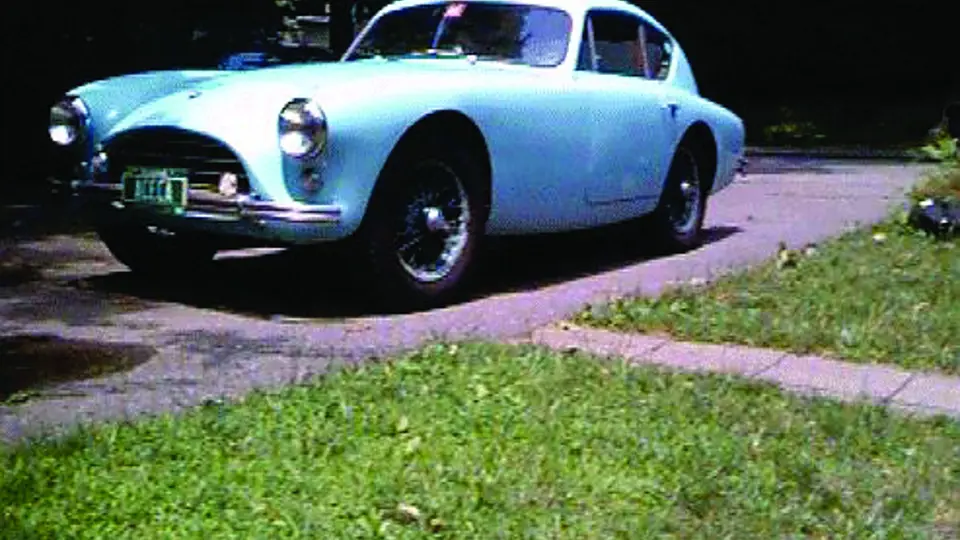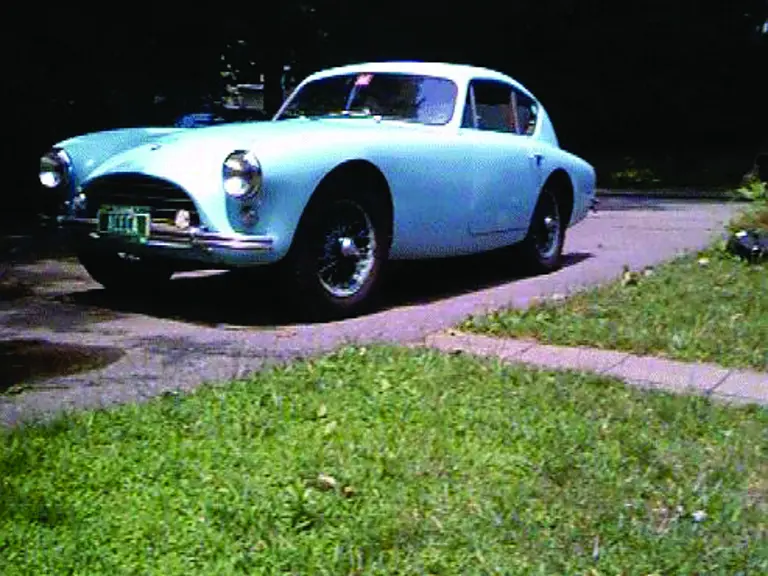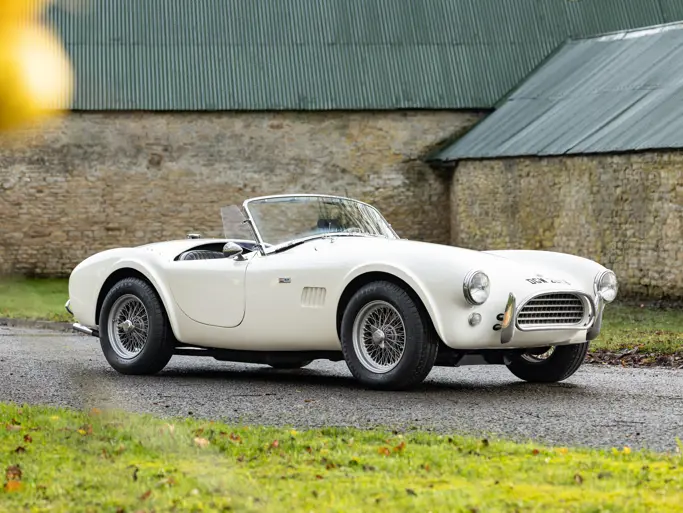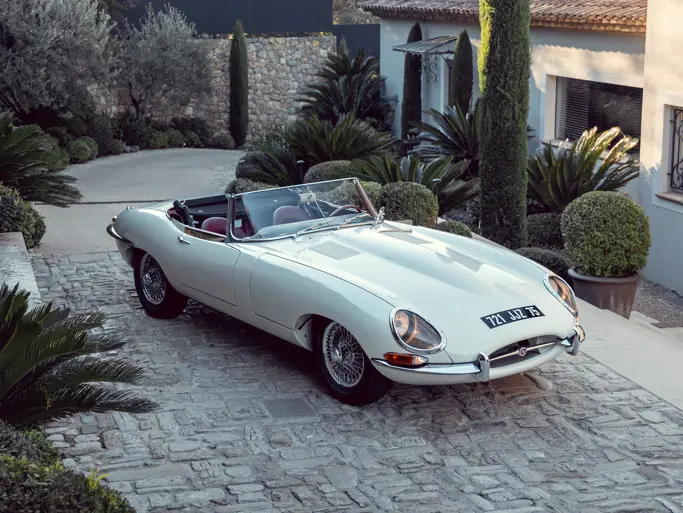
1963 AC Aceca
{{lr.item.text}}
$77,000 USD | Sold
AEX-796 "The Missing USA Aceca"
{{bidding.lot.reserveStatusFormatted}}
- 1,991-cc, 90-hp inline six-cylinder engine
- Manual transmission with overdrive
- Second owner; since 1967
- Referred by writers as "The Missing USA Aceca"
- In need of mechanical sorting or restoration
- Reported as "in fair to good condition"
- Many years of storage
- Approximately 300 Acecas reported built
- Well-received and admired vehicle upon introduction
AC Cars originated as one of the first British automobile manufacturers, with production dating back to 1901. The company established a successful competition record in the years between the wars and emerged intact in the post-war era to produce one of the most significant sports cars in history. That car was the AC Ace, an open two-seater sports car based on a design originally created by John Tojiero.
AC placed Tojiero’s design into production in 1953 and had it powered by a two-liter engine in a tube frame chassis, also of Tojiero’s design, with front and rear independent suspension. Racing successes would follow. A second model, the AC Aceca, was introduced at the 1954 London Motor Show. The Aceca was designed to be an attractive coupe variant of the Ace roadster, but with greater refinement and luxury features.
The Aceca’s chassis was similar to the Ace’s tube frame and independent suspension, with heavier duty main rails and an extra cross member. The chassis was also more highly developed and received rubber mountings on the differential to reduce vibration and noise within the closed cabin. Fiberglass panels were also placed between both the front and rear bulkheads of the cabin, to provide added sound insulation. The cabin was finished with leather, wood, and wool carpets, further adding to the coupe’s refinement.
Road & Track magazine was excited to get their hands on the AC Aceca-Bristol Coupe; they knew it was going to have similar positive traits as seen on the AC Ace Roadster, in particular the car’s handling qualities and performance. They did not expect the AC Aceca to provide any surprises, but the test crew was happily proven wrong. The surprise came from the cars “totally unexpected smoothness, quietness and general all-around tractability.” They extolled its virtues by declaring that “Grand Turismo is spelled the same way in England….it is a most pleasant machine, suitable for everyday driving yet particularly designed for fast cruising over long distances.”
The current owner of this particular 1962 AC Aceca (AEX-796) shares the following personal story and background as the second owner of this machine, now fast approaching 50 years.
“Dr. Kendall Frost, the original owner, gave the Aceca to my father when the car blew a head gasket in 1967, and Dr. Frost decided to purchase an Alfa. My father gave the car to me to repair. I communicated with Mr. D. Taylor, Parts Stores Manager at AC Car Company in Thames Ditton in the late 1960s and early 1970s, to have parts shipped to Vermont.
I actually met Mr. Taylor in the summer of 1972. He was quite on in years and very tall. I could swear he blew the dust off an old ledger that he took from a shelf and placed on his desk. ‘Now which car was it,’ he asked? I told him it was sold to Kendall Frost, a medical doctor in Vermont. ‘Oh, yes, I remember Dr. Frost and that car,’ he said, and proceeded to describe the vehicle in some detail, including the original white color, the installed overdrive and center-release aircraft safety harness. He gave us a tour of their restoration shop, with many ACs in various stages of tear-down.
I maintained this Aceca for many years, and I drove it in college and law school, 1974 to ‘77. It went into storage in 1978, when I left Vermont and moved to California for more than a decade. Many stories are associated with this beautiful car, including this one:
My father and brother took it out of storage and spiffed it up for my wedding in 1982. My bride and I got to Hanover, New Hampshire on the first day of our honeymoon and stopped for coffee. When we emerged, a crowd was around the car and gasoline was pouring from a leak in the gas tank. The crowd had called the fire department; but my bride and I decided that would ruin our day, so we started up and drove it back to my brother, trailing a line of gasoline; we hadn't thought about the traditional tin cans that had been tied to the rear bumper, and my bride watched carefully for sparks igniting the gasoline on the way back to Vermont! My brother loaned us his car and we had a stainless-steel tank made to replace the original gas tank (the gas tank being the only non-original part today).
I drove it again briefly in the early 1990s, when I took it to a British sports car shop in Nashua, New Hampshire, where I had a frustrating experience: they stored it outdoors, damaging the paint, and when I got it back, some of the original tools were missing, including my entire set of Whitworth wrenches and sockets that I'd purchased years before. At about the same time a weld point broke on the tubular frame and I didn't feel the car was/is safe to drive over 30 miles per hour, so it returned to garage storage around 1995. I started the engine fairly regularly until about 2007, and since then have simply turned the engine over with a crank periodically to ensure the cylinders stay loose. The car was moved by trailer in 2008, when we discovered a problem in the differential prevented it being rolled backwards. Fortunately the car is so light that it can be jacked onto dolleys and moved quite easily. It rolls forward without a problem."
This specific Aceca (AEX-796) is one of the last Acecas built and is referred to as both the 'Frost/Lancaster' and the ‘Missing USA Aceca’ by one or more authors writing about these models. They know it had left-hand drive and was shipped to the United States at purchase. Reported as being in “fair to good” condition and restored once in the mid-1970s; this AC Aceca is stated to be “basically a barn find; it has been sitting with long term owners and is need of restoration and major service before being again being roadworthy.” It was fully restored in 1976 by the owner, assisted by a Czech auto technician (Mr. Smola of White River Junction, Vermont). The owner states; "My mother and I removed the engine and tore it down fully, sending it to Thames Ditton for the replacement gasket and some needed replacement studs. Smola disassembled the body, went over the frame, and then reassembled the whole vehicle and repainted it in a light sky blue."
This AC Aceca has never before been offered for sale or been presented for public viewing.
This would be a most worthwhile endeavor as multiple sources indicate that there were only around 325 total cars built during the Aceca’s 1954 to 1963 availability. There were different engines available and this is broken down as 151 Acecas (like AEX-796), 169 Aceca-Bristols and 8 Ford-engined models had been built when production halted in 1963.
This car is powered by the 1,991-cc, 90-hp inline six-cylinder engine that has three side-draft one-barrel SU carburetors and is paired up with a Moss four-speed manual gearbox with overdrive in second, third and fourth gear. Engine number CLB2456WT is onboard and is reported as original to the car. The styling is impeccably suited to the era in which it came to the fore and is notable for the hatchback feature at the rear, making the Aceca only the second car, after the 1953 Aston Martin DB2/4, to incorporate this element that allowed easy cabin and storage access. The AC Aceca also has five original 56-spoke, 16-inch wire wheels, two-ear knock-offs, foglights, original black leather bucket-type seats, original sunshades, original steering wheel, original dash wood, double-shoulder center-release aircraft harness seatbelts, complete instrumentation, original owner's manual and the period presence that inspired James Bond creator, Ian Fleming, to purchase a similar Aceca for himself.
Complete biographies of the cars owners accompany the AC, as does written correspondence with AC Cars Ltd. plus AC Cars invoices (original and copies) for parts. As referenced earlier, the car needs minor structural welding and differential repair for roadability, but the mileage is said to be approximately 60,000 and this, along with it being stored inside for most of its years, indicates a very solid, primarily original platform to be returned to its former magnificence. To even further the importance of this AC. having it known as “the Missing USA Aceca” with a two-owner history allows you to explore the many stories that will reveal its past years of obviously treasured family tenure. All the while, you’ll be making numerous memories of your own.


 | Hilton Head Island, South Carolina
| Hilton Head Island, South Carolina


